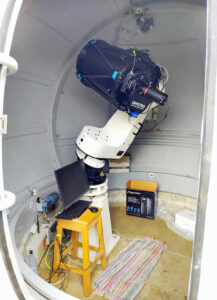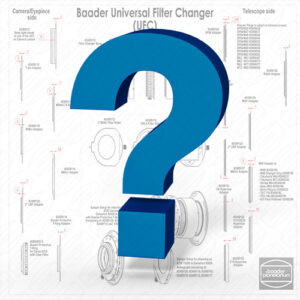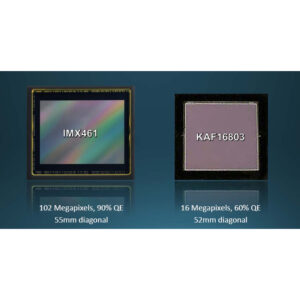Baader Planetarium Blog Posts
-
Adapting the M68 Tilter for use with T-2 and M48 Accessories
This entry was posted on April 26, 2023 Last modified on February 27, 2024.
The Baader M68-Tilter (#2458170 , € 255,-) The M68 system allows for a sturdy and rigid connection of heavy accessories. The M68 tilter is a relatively recent addition to this family of adaptors and was developed to easily compensate for image tilt in an optical train through simple adjustments of three pairs of easily-accessible (even when a camera for example is attached) hex-screws located around the edge of the adaptor. Although the M68 tilter itself is small occupying just 9.50-10.25mm of optical path length, and relatively light weighing in at just under 100g, it can accommodate a heavy accessory payload of up to 5kg. The tilter allows a tilt shift of up to 1° to compensate for misalignments in the image field. Baader M68 adapter...
-
Alston Observatory's (University of Central Lancashire UK) New PlaneWave Installation - Part 3: The DeltaRho350
This entry was posted on April 4, 2023 Last modified on February 28, 2024.
Towards the end of 2021 Alston Observatory, which is the teaching and public outreach facility of the University of Central Lancashire's Jeremiah Horrocks Institute for Astronomy, Maths and Physics in the north-west of the UK had their PlaneWave L-350 direct drive mount installed atop an equatorial wedge on a Baader heavy duty 0.6m pier in their new 3m observatory dome. After it was installed a Meade 12" LX200 SCT was temporarily mounted on this system waiting for the telescope to arrive that would finally "live" on the mount.....a PlaneWave DeltaRho 350 F/3 widefield imaging cassegrain optical system - the first such PlaneWave telescope system in the United Kingdom. In this third and final installment of the Alston Observatory telescope installation (see here for part one...
-
First images with the TEC200FL
This entry was posted on March 17, 2023 Last modified on February 27, 2024.
The following statement and pictures were sent to us by our customer Bernhard Hubl. Hello astrophotographers, I am pleased to present to you today the First Light with the QHY 268M on the TEC APO 200 FL. The planetary nebula Abell 12 is perfect for testing the combination of optics, camera and filter in terms of star formation, halos, reflections and sharpness. It is not without reason that Abell 12 has the nickname "Hidden planetary nebula". This faint PN is hidden in the halo of the 4 mag bright star Mu Orionis. Only if all optical components work perfectly together and of course the seeing is favourable, this PN can be imaged well. My plan was to separate the PN cleanly from the bright star...
-
Baader Planetarium and 10Micron at the Practical Astronomy Show UK
This entry was posted on March 17, 2023 Last modified on February 28, 2024.
Saturday March 11th saw the welcome return of the one-day Practical Astronomy Show (PAS) which was held at its usual venue at the Kettering Conference Centre located in the heart of England. The event hosts a large number of retailers and manufacturers and the event is free for the public to attend. Alongside the trade exhibition there are also a number of free talks spread across the day. Exhibitors usually set up the day beforehand, but storm Larisa hit large parts of the UK on the Thursday and Friday with heavy snow and cold temperatures leading to treacherous travel conditions for some (including our UK representative). Luckily all exhibitors who planned to attend did so and the weather improved considerably for the public attendees to...
-
All important helper tools at a glance
Discover on our page all the essential helper tools specially developed to facilitate your selection for astronomical observations. From specific filter selectors to custom-made dovetail rails, we offer solutions tailored to your needs. Learn more about our products and how they can change your view of the sky. Baader Narrowband/Highspeed Filter Selector To make it easy for you in the future to decide which kind of Highspeed (or Narrowband) filter you need for your telescope, please check the filter selector that provides you the correct individual graph based on your entries. Filter Selector Baader Solar Filter Finder How do I find the right solar filter for my instrument? Use our Baader Solar Filter Finder and choose your observation device. Baader Solar Filter Finder 2" ClickLock®...
-
Product News: March 2023
This entry was posted on March 10, 2023 Last modified on February 28, 2024.
Baader 2" Cool-Ceramic Safety Herschelprism Mark II (Visual / Photo) 2" wedge prism according to Herschel - one-sided Phantom Group® anti-reflective coating, with ceramic solar finder and 2" ClickLock® eyepiece holder Integrated rotation mechanism for polarising filters – the best method for brightness adjustment in visual solar observation and solar photography in white light Stepless brightness adjustment is made possible in combination with the optional and the included Neutral Density Filter. The polarizing filters are not included in the scope of delivery Including the for an uncompromisingly sharp solar image S58 dovetail and Safety Kerfs on the 2" nose-piece, New 3-point adjustment system preset in the factory Available in visual and photographic versions, please choose from dropdown Baader Calzium GEN-II 1¼" with LPFC Single filter...
-
QHY461M Photo
This entry was posted on March 9, 2023 Last modified on February 28, 2024.
The QHY461 PH (photo) is a monochrome BSI CMOS camera with 102 MegaPixel, 16bit AD conversion, highest quantum efficiency with extremely low readout noise. New - especially for amitious amateur astrophotographs - The monochrome QHY461M PHis a completely new development of the larger, scientific camera of the monochrome model QHY461M-Pro. It has a more compact body and does NOT have the scientific features of the QHY 461 M/C PRO, BSI Cooled Scientific Cameras (various versions available) . These include the two 2 x 10 GB fiber interfaces, GPS timing, programmable FPGA and the external trigger input. An optional additional water cooling is also not available. Data is transferred to the PC via a standard USB 3.0 interface. Otherwise, the performance of the QHY461M PH...
-
New QHY 5 III series of planetary and guiding cameras
This entry was posted on November 18, 2022 Last modified on February 28, 2024.
Update 05/2023: New OHY Planetary- and Guiding Camera QHY 5 III 678 M/C The QHY 5 III 678 M/C is the latest evolution of version 2 of the QHY 5III series of planetary and guiding cameras. The QHY 5 III 678 M/C can be considered an improved version of its predecessor, the QHY 5-III-178M CMOS Camera (#1931024 , € 375,-) . Like the Sony IMX 178, the new IMX 678 sensor from Sony is a back illuminated (BSI) sensor in 1/1.8 inch format. However, compared to the IMX 178, it has a higher resolution (smaller pixels) and a higher QE, as well as increased sensitivity in the near infrared spectral range (NIR). In addition, the QHY 5 III 678 M/C camera modules has the...
-
A comparison of the technical data between the Sony CMOS sensor IMX 461 and the Kodak CCD KAF 16803 sensor - CMOS vs.CCD
This entry was posted on March 9, 2023 Last modified on February 19, 2024.
Introduction For several decades monochrome CCD sensors were THE choice for astronomical image acquisition, be it for imaging, astrometric or photometric applications. At the beginning of the technical development, CCD sensors were much smaller in area than the standard 24 x 35 mm format, but they were much more sensitive and did not suffer from the reciprocity error (the black screen effect), a classical problem of all standard film emulsions. However, CCD sensors were very expensive - initially reserved for professional astronomy - and it took some time before 35mm-sized sensors were available at prices that amateurs could afford. In addition, the pixel dimensions were large (9 µm and larger) and thus hardly usable for short focal length imaging optics. In the meantime, telescope optics...
-
Baader Planetarium at European AstroFest London 2023
This entry was posted on February 8, 2023 Last modified on February 28, 2024.
The European AstroFest returned to its usual London home last weekend, the first since 2020 which took place just before the start of the global pandemic. This two day event was held at the Kensington Conference and Events Centre on Friday 3rd and Saturday 4th February. The event featured 3 floors of exhibition space showing the latest astro-gear from a range of suppliers and retailers. Over the two day event a total of 16 talks were given by astronomers and space scientists, including historian Professor Allan Chapman and Queen lead guitarist (and astronomer) Brian May. Baader Planetarium were invited to be part of the event by Dr Simon Bennett and Elena Kostyaeva from The Widescreen Centre and our UK representative attended on our behalf. We...















